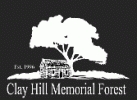Bat Research We have used an ultrasonic recorder for passive monitoring of bats at Clay Hill for several years. The monitor records bat calls automatically. We have one CU alumnus who used the data for her senior research. She recognized six species of bat at Clay Hill. The research is geared toward identifying the bats that use the forest and to determine when they utilize it. This student won recognition from two professional organizations....Sigma Zeta, a national science honor society, and the Kentucky Academy of Sciences. Research on the Distribution of Large Mammals at CHMF Another recent graduate used videos recorded by remote wildlife cameras to determine which mammals were present at the forest and to determine where there most often occurred. Many hours of video were recorded documenting the occurrence of coyote, bobcat, redfox, grayfox, oppossum, raccoon, longtailed weasel, flying squirrel and many others. Research on the Distribution of Salamanders and Orchids. Our students are now mapping the distribution of these species at Clay Hill. One of the goals of this distributional research is to collect biological data linked to location using GPS recievers. All of these data are being plotted on our maps. The maps are drawn using ArcGIS. Kentucky Utilities Field Day Series For several years we have conduct a series of onsite field days. Middle and Senior High Students from area schools will spend a "Day with a Scientist" at CHMF with all expenses paid by a grant from Kentucky Utilities. Topics have included amphibian and reptile biology, bird biology, raptor rehabilitation, bat monitoring, dating historic buildings using tree ring data, archaeology and paleontology. Engage your students in science by taking a day to let them see how scientists work. If you are interested please contact us and reserve space. Wi Fi Visitors to Clay Hill now have access to free Wi Fi as guests on the clayhillforest network. This allows them to access information about history and natural history when no staff are on site. We hope to extend the Wi Fi signal well into the forest. Smart phones equipped with QR code readers (generally a free app) can connect visitors with our website and with other sites where they can read about the history of CHMF, listen to audio messages or view short videos. The CHMF Wi Fi site is clayhillforest-guest. The password is "CHMF". Visitors come to CHMF for various reasons not the least of which is to study the rich history of the farm it came from. In the past this has been difficult because of the lack of readily available information. In Winter 2013-2014, we added interactive trail signs along the PRIDE Ecological Succession Trail. These signs link hikers with smart phones to online information including transcriptions of historic Sanders and White family documents. This new signage uses QR barcodes. So bring your smart phone to CHMF to learn about the Civil War History of the farm. New Weather Station In March of 2014 we replaced our onsite weather stations. The new station collects data every five minutes and then uploads these data once each hour to a commercial website (HoboLink©) and to the Weather Underground© website. The data are available for download. Our old weather website is offline but may be restored at a later date. Kentucky Utilities Alternative Energy Site In winter 2014, we built and installed a much improved solar energy charge controller and power distribution panel in this facility. The old system had become obsolete. The new system has the capacity to add more solar panels and battery storage. Because this facility is not often open to the community, we are working on informative signage and brochures that will be available at the site. Also the interactive exhibits in this facility are being redesigned. Clay Hill Log Cabin Age Determined In summer 2013, we had cores taken from logs in our cabin. This was done by a biologist from Hanover College, Indiana, who is a Dendroarcheologist . A scientist who determines the age of manmade structures by examining the pattern of growth in trees that were used for timbers. Our cabin is made mostly of tulip poplar (yellow poplar) logs but has a few American chestnut logs in its walls and red and white oak logs as floor joists. The oldest log had an initial date of 1705. This tells us that some of the trees in the cabin were growing at Clay Hill long before European settlers came to the site. The last growth rings in the logs indicate the year the tree was cut down. Most of the logs in our cabin had last dates of 1883. So it is very likely that the cabin was made around that time. A second log cabin was dated using the same techniques. This cabin was built in 1844 making it one of the earliest structures in this region. Unfortunately, this cabin was beyond restoring so it was torn down. We were able to salvage enough logs from it to reconstruct a smaller cabin. This project is an exciting one because we believe we know who built the cabin and we know a lot about how it was build. When completed this building will serve are a small historical exhibit. Ken Weddle Learning Center for Sight-Impaired Children During summer 2013, we added many hands-on exhibits at this center. It is now equipped with three audio stations where visitors can listen to several prerecorded interpretive messages by turning a hand crank. The energy for these audio boxes is generated by the kids who crank them. We also installed fossil exhibits where students can see and touch fossils that were found at CHMF as well as older fossils from the bluegrass area of Kentucky and southwestern Indiana. The fossils include one slab that is approximately two feet wide and four feet tall that came from CHMF. This slab is thought to be trace fossils formed when animals crawled through mud and left trails. We also have a large coral fossil that came from Washington County. Inside the building at this site, students can touch framed leaf imprints and bark samples mounted along one wall and examine fruits and seeds of many of CHMF's native trees. These exhibits are being expanded. In 2014 we purchased and installed a three dimensional map of CHMF. This is accessible to all CHMF visitors because of its location on the outside of the building. The map and other planned exhibits will teach students about the meaning of drainage basins as well as surface water runoff. Self Study of CHMF During 2012-2013, we drafted and published a comprehensive history of CHMF that will be used for charting the future of CHMF. As a part of this writing process, we conducted surveys and hosted focus group meetings with individuals and groups who have utilized or could utilize CHMF. We gained a great deal of insight into our successes and failures and are using this insight to make CHMF even better. Added Land In spring 2013 the Feather Creek Nature Preserve was transferred to Campbellsville University by Taylor Co., Fiscal Court. CHMF had partnered with the court to purchase this land with funds from the Kentucky Heritage Land Conservation Fund (KHLCB) in 2009. In December 2012, we purchased 94 acres of land next to our Edwin Lee White Sr. Nature Preserve and Feather Creek Nature Preserve. This purchase was made possible by a grant from the KHLCB. This grant represented the first time that KHLCB had funded a private university in Kentucky. In spring 2013, we planted 29 acres of native hardwood trees (20,000) on this property and in early summer 2013 we planted 17-acres of native grasses and wildflowers on the gas pipleline and electric transmission easements. These easements are connected with grass corridors that establish a 17-acre restored prairie. In 2015, we purchased 39 adjacent acres, increasing the total acreage of CHMF to 305. All funds for this purchase and the restorations to all added properties were included in the original KHLCB grants. CHMF has grown from the original 128.5 acres to it current size at very little cost the the University. If fact by acquiring land using KHLCB grants we have received enough funding to allow our students to do research that would not have been possible elsewise. Reforestation and Prairie Establishment The total land area of CHMF was increased to 305 acres. Management of the newly acquired lands are ongoing. A major effort has been initiated to elimate invasive plant species including multiflora rose, tree of heaven, winter creeper and various other species. With assistance and support from the university, we were able to purchase a tractor for use with management. This tractor replaces an old orchard tractor that was, because of its narrow wheel base, really unsafe to use on the terrain at CHMF. Bioinventory We have initiated work to determine the plant and animal species that occupy the property. In summer 2012, we began work on a comprehenisve flora of the entire property. This work is ongoing with additions to our list being made almost every week during the growing season. Currently the plant list totals over 450 species. We have also began to work on a bird list and on lists for salamanders and frogs, lizards and snakes, and mammals. As we learn about the different kinds of plants and animals that inhabit CHMF, we are locating the species using GPS and transferring the data to our comprehensive Geographic Information Systems map for CHMF. The bioinventories will be used for faculty and student research and for teaching field techniques and natural history to our students.
|




